Three simple numbers that add up to global catastrophe - and that make clear who the real enemy is
July 19, 2012 9:35 AM ET
If the pictures of those towering wildfires in
Colorado haven't convinced you, or the size of your AC bill this summer,
here are some hard numbers about climate change: June broke or tied
3,215 high-temperature records across the United States. That followed
the warmest May on record for the Northern Hemisphere – the 327th
consecutive month in which the temperature of the entire globe exceeded
the 20th-century average, the odds of which occurring by simple chance
were 3.7 x 10-99, a number considerably larger than the number of stars
in the universe.

Meteorologists reported that this spring was the warmest ever
recorded for our nation – in fact, it crushed the old record by so much
that it represented the "largest temperature departure from average of
any season on record." The same week, Saudi authorities reported that it
had rained in Mecca despite a temperature of 109 degrees, the hottest
downpour in the planet's history.
Not that our leaders seemed to notice. Last month the world's
nations, meeting in Rio for the 20th-anniversary reprise of a massive
1992 environmental summit, accomplished nothing. Unlike George H.W.
Bush, who flew in for the first conclave, Barack Obama didn't even
attend. It was "a ghost of the glad, confident meeting 20 years ago,"
the British journalist George Monbiot wrote; no one paid it much
attention, footsteps echoing through the halls "once thronged by
multitudes." Since I wrote one of the first books for a general audience
about global warming way back in 1989, and since I've spent the
intervening decades working ineffectively to slow that warming, I can
say with some confidence that we're losing the fight, badly and quickly –
losing it because, most of all, we remain in denial about the peril
that human civilization is in.
When we think about global warming at all, the arguments tend to be
ideological, theological and economic. But to grasp the seriousness of
our predicament, you just need to do a little math. For the past year,
an easy and powerful bit of arithmetical analysis first published by
financial analysts in the U.K. has been making the rounds of
environmental conferences and journals, but it hasn't yet broken through
to the larger public. This analysis upends most of the conventional
political thinking about climate change. And it allows us to understand
our precarious – our almost-but-not-quite-finally hopeless – position
with three simple numbers.
The First Number: 2° Celsius
If
the movie had ended in Hollywood fashion, the Copenhagen climate
conference in 2009 would have marked the culmination of the global fight
to slow a changing climate. The world's nations had gathered in the
December gloom of the Danish capital for what a leading climate
economist, Sir Nicholas Stern of Britain, called the "most important
gathering since the Second World War, given what is at stake." As Danish
energy minister Connie Hedegaard, who presided over the conference,
declared at the time: "This is our chance. If we miss it, it could take
years before we get a new and better one. If ever."
In the event, of course, we missed it. Copenhagen failed
spectacularly. Neither China nor the United States, which between them
are responsible for 40 percent of global carbon emissions, was prepared
to offer dramatic concessions, and so the conference drifted aimlessly
for two weeks until world leaders jetted in for the final day. Amid
considerable chaos, President Obama took the lead in drafting a
face-saving "Copenhagen Accord" that fooled very few. Its purely
voluntary agreements committed no one to anything, and even if countries
signaled their intentions to cut carbon emissions, there was no
enforcement mechanism. "Copenhagen is a crime scene tonight," an angry
Greenpeace official declared, "with the guilty men and women fleeing to
the airport." Headline writers were equally brutal: COPENHAGEN: THE
MUNICH OF OUR TIMES? asked one.
The accord did contain one important number, however. In Paragraph 1,
it formally recognized "the scientific view that the increase in global
temperature should be below two degrees Celsius." And in the very next
paragraph, it declared that "we agree that deep cuts in global emissions
are required... so as to hold the increase in global temperature below
two degrees Celsius." By insisting on two degrees – about 3.6 degrees
Fahrenheit – the accord ratified positions taken earlier in 2009 by the
G8, and the so-called Major Economies Forum. It was as conventional as
conventional wisdom gets. The number first gained prominence, in fact,
at a 1995 climate conference chaired by Angela Merkel, then the German
minister of the environment and now the center-right chancellor of the
nation.
Some context: So far, we've raised the average temperature of the
planet just under 0.8 degrees Celsius, and that has caused far more
damage than most scientists expected. (A third of summer sea ice in the
Arctic is gone, the oceans are 30 percent more acidic, and since warm
air holds more water vapor than cold, the atmosphere over the oceans is a
shocking five percent wetter, loading the dice for devastating floods.)
Given those impacts, in fact, many scientists have come to think that
two degrees is far too lenient a target. "Any number much above one
degree involves a gamble," writes Kerry Emanuel of MIT, a leading
authority on hurricanes, "and the odds become less and less favorable
as the temperature goes up." Thomas Lovejoy, once the World Bank's chief
biodiversity adviser, puts it like this: "If we're seeing what we're
seeing today at 0.8 degrees Celsius, two degrees is simply too much."
NASA scientist James Hansen, the planet's most prominent climatologist,
is even blunter: "The target that has been talked about in
international negotiations for two degrees of warming is actually a
prescription for long-term disaster." At the Copenhagen summit, a
spokesman for small island nations warned that many would not survive a
two-degree rise: "Some countries will flat-out disappear." When
delegates from developing nations were warned that two degrees would
represent a "suicide pact" for drought-stricken Africa, many of them
started chanting, "One degree, one Africa."
Despite such well-founded misgivings, political realism bested
scientific data, and the world settled on the two-degree target –
indeed, it's fair to say that it's the only thing about climate change
the world has settled on. All told, 167 countries responsible for more
than 87 percent of the world's carbon emissions have signed on to the
Copenhagen Accord, endorsing the two-degree target. Only a few dozen
countries have rejected it, including Kuwait, Nicaragua and Venezuela.
Even the United Arab Emirates, which makes most of its money exporting
oil and gas, signed on. The official position of planet Earth at the
moment is that we can't raise the temperature more than two degrees
Celsius – it's become the bottomest of bottom lines. Two degrees.
The Second Number: 565 Gigatons
Scientists
estimate that humans can pour roughly 565 more gigatons of carbon
dioxide into the atmosphere by midcentury and still have some reasonable
hope of staying below two degrees. ("Reasonable," in this case, means
four chances in five, or somewhat worse odds than playing Russian
roulette with a six-shooter.)
This idea of a global "carbon budget" emerged about a decade ago, as
scientists began to calculate how much oil, coal and gas could still
safely be burned. Since we've increased the Earth's temperature by 0.8
degrees so far, we're currently less than halfway to the target. But, in
fact, computer models calculate that even if we stopped increasing CO
2
now, the temperature would likely still rise another 0.8 degrees, as
previously released carbon continues to overheat the atmosphere. That
means we're already three-quarters of the way to the two-degree target.
How good are these numbers? No one is insisting that they're exact,
but few dispute that they're generally right. The 565-gigaton figure was
derived from one of the most sophisticated computer-simulation models
that have been built by climate scientists around the world over the
past few decades. And the number is being further confirmed by the
latest climate-simulation models currently being finalized in advance of
the next report by the Intergovernmental Panel on Climate Change.
"Looking at them as they come in, they hardly differ at all," says Tom
Wigley, an Australian climatologist at the National Center for
Atmospheric Research. "There's maybe 40 models in the data set now,
compared with 20 before. But so far the numbers are pretty much the
same. We're just fine-tuning things. I don't think much has changed over
the last decade." William Collins, a senior climate scientist at the
Lawrence Berkeley National Laboratory, agrees. "I think the results of
this round of simulations will be quite similar," he says. "We're not
getting any free lunch from additional understanding of the climate
system."
We're not getting any free lunch from the world's economies, either.
With only a single year's lull in 2009 at the height of the financial
crisis, we've continued to pour record amounts of carbon into the
atmosphere, year after year. In late May, the International Energy
Agency published its latest figures – CO
2 emissions last
year rose to 31.6 gigatons, up 3.2 percent from the year before. America
had a warm winter and converted more coal-fired power plants to natural
gas, so its emissions fell slightly; China kept booming, so its carbon
output (which recently surpassed the U.S.) rose 9.3 percent; the
Japanese shut down their fleet of nukes post-Fukushima, so their
emissions edged up 2.4 percent. "There have been efforts to use more
renewable energy and improve energy efficiency," said Corinne Le Quéré,
who runs England's Tyndall Centre for Climate Change Research. "But what
this shows is that so far the effects have been marginal." In fact,
study after study predicts that carbon emissions will keep growing by
roughly three percent a year – and at that rate, we'll blow through our
565-gigaton allowance in 16 years, around the time today's preschoolers
will be graduating from high school. "The new data provide further
evidence that the door to a two-degree trajectory is about to close,"
said Fatih Birol, the IEA's chief economist. In fact, he continued,
"When I look at this data, the trend is perfectly in line with a
temperature increase of about six degrees." That's almost 11 degrees
Fahrenheit, which would create a planet straight out of science fiction.
So, new data in hand, everyone at the Rio conference renewed their
ritual calls for serious international action to move us back to a
two-degree trajectory. The charade will continue in November, when the
next Conference of the Parties (COP) of the U.N. Framework Convention on
Climate Change convenes in Qatar. This will be COP 18 – COP 1 was held
in Berlin in 1995, and since then the process has accomplished
essentially nothing. Even scientists, who are notoriously reluctant to
speak out, are slowly overcoming their natural preference to simply
provide data. "The message has been consistent for close to 30 years
now," Collins says with a wry laugh, "and we have the instrumentation
and the computer power required to present the evidence in detail. If we
choose to continue on our present course of action, it should be done
with a full evaluation of the evidence the scientific community has
presented." He pauses, suddenly conscious of being on the record. "I
should say, a
fuller evaluation of the evidence."
So far, though, such calls have had little effect. We're in the same
position we've been in for a quarter-century: scientific warning
followed by political inaction. Among scientists speaking off the
record, disgusted candor is the rule. One senior scientist told me, "You
know those new cigarette packs, where governments make them put a
picture of someone with a hole in their throats? Gas pumps should have
something like that."
The Third Number: 2,795 Gigatons
This
number is the scariest of all – one that, for the first time, meshes
the political and scientific dimensions of our dilemma. It was
highlighted last summer by the Carbon Tracker Initiative, a team of
London financial analysts and environmentalists who published a report
in an effort to educate investors about the possible risks that climate
change poses to their stock portfolios. The number describes the amount
of carbon already contained in the proven coal and oil and gas reserves
of the fossil-fuel companies, and the countries (think Venezuela or
Kuwait) that act like fossil-fuel companies. In short, it's the fossil
fuel we're currently planning to burn. And the key point is that this
new number – 2,795 – is higher than 565. Five times higher.
The Carbon Tracker Initiative – led by James Leaton, an
environmentalist who served as an adviser at the accounting giant
PricewaterhouseCoopers – combed through proprietary databases to figure
out how much oil, gas and coal the world's major energy companies hold
in reserve. The numbers aren't perfect – they don't fully reflect the
recent surge in unconventional energy sources like shale gas, and they
don't accurately reflect coal reserves, which are subject to less
stringent reporting requirements than oil and gas. But for the biggest
companies, the figures are quite exact: If you burned everything in the
inventories of Russia's Lukoil and America's ExxonMobil, for instance,
which lead the list of oil and gas companies, each would release more
than 40 gigatons of carbon dioxide into the atmosphere.
Which is exactly why this new number, 2,795 gigatons, is such a big
deal. Think of two degrees Celsius as the legal drinking limit –
equivalent to the 0.08 blood-alcohol level below which you might get
away with driving home. The 565 gigatons is how many drinks you could
have and still stay below that limit – the six beers, say, you might
consume in an evening. And the 2,795 gigatons? That's the three 12-packs
the fossil-fuel industry has on the table, already opened and ready to
pour.
We have five times as much oil and coal and gas on the books as
climate scientists think is safe to burn. We'd have to keep 80 percent
of those reserves locked away underground to avoid that fate. Before we
knew those numbers, our fate had been likely. Now, barring some massive
intervention, it seems certain.
Yes, this coal and gas and oil is still technically in the soil. But
it's already economically aboveground – it's figured into share prices,
companies are borrowing money against it, nations are basing their
budgets on the presumed returns from their patrimony. It explains why
the big fossil-fuel companies have fought so hard to prevent the
regulation of carbon dioxide – those reserves are their primary asset,
the holding that gives their companies their value. It's why they've
worked so hard these past years to figure out how to unlock the oil in
Canada's tar sands, or how to drill miles beneath the sea, or how to
frack the Appalachians.
If you told Exxon or Lukoil that, in order to avoid wrecking the
climate, they couldn't pump out their reserves, the value of their
companies would plummet. John Fullerton, a former managing director at
JP Morgan who now runs the Capital Institute, calculates that at today's
market value, those 2,795 gigatons of carbon emissions are worth about
$27 trillion. Which is to say, if you paid attention to the scientists
and kept 80 percent of it underground, you'd be writing off $20 trillion
in assets. The numbers aren't exact, of course, but that carbon bubble
makes the housing bubble look small by comparison. It won't necessarily
burst – we might well burn all that carbon, in which case investors will
do fine. But if we do, the planet will crater. You can have a healthy
fossil-fuel balance sheet, or a relatively healthy planet – but now that
we know the numbers, it looks like you can't have both. Do the math:
2,795 is five times 565. That's how the story ends.
So
far, as I said at the start, environmental efforts to tackle global
warming have failed. The planet's emissions of carbon dioxide continue
to soar, especially as developing countries emulate (and supplant) the
industries of the West. Even in rich countries, small reductions in
emissions offer no sign of the real break with the status quo we'd need
to upend the iron logic of these three numbers. Germany is one of the
only big countries that has actually tried hard to change its energy
mix; on one sunny Saturday in late May, that northern-latitude nation
generated nearly half its power from solar panels within its borders.
That's a small miracle – and it demonstrates that we have the technology
to solve our problems. But we lack the will. So far, Germany's the
exception; the rule is ever more carbon.
This record of failure means we know a lot about what strategies
don't
work. Green groups, for instance, have spent a lot of time trying to
change individual lifestyles: the iconic twisty light bulb has been
installed by the millions, but so have a new generation of
energy-sucking flatscreen TVs. Most of us are fundamentally ambivalent
about going green: We like cheap flights to warm places, and we're
certainly not going to give them up if everyone else is still taking
them. Since all of us are in some way the beneficiaries of cheap fossil
fuel, tackling climate change has been like trying to build a movement
against yourself – it's as if the gay-rights movement had to be
constructed entirely from evangelical preachers, or the abolition
movement from slaveholders.
People perceive – correctly – that their individual actions will not
make a decisive difference in the atmospheric concentration of CO2; by
2010, a poll found that "while recycling is widespread in America and 73
percent of those polled are paying bills online in order to save
paper," only four percent had reduced their utility use and only three
percent had purchased hybrid cars. Given a hundred years, you could
conceivably change lifestyles enough to matter – but time is precisely
what we lack.
A more efficient method, of course, would be to work through the
political system, and environmentalists have tried that, too, with the
same limited success. They've patiently lobbied leaders, trying to
convince them of our peril and assuming that politicians would heed the
warnings. Sometimes it has seemed to work. Barack Obama, for instance,
campaigned more aggressively about climate change than any president
before him – the night he won the nomination, he told supporters that
his election would mark the moment "the rise of the oceans began to slow
and the planet began to heal." And he has achieved one significant
change: a steady increase in the fuel efficiency mandated for
automobiles. It's the kind of measure, adopted a quarter-century ago,
that would have helped enormously. But in light of the numbers I've just
described, it's obviously a very small start indeed.
At this point, effective action would require actually keeping most
of the carbon the fossil-fuel industry wants to burn safely in the soil,
not just changing slightly the speed at which it's burned. And there
the president, apparently haunted by the still-echoing cry of "Drill,
baby, drill," has gone out of his way to frack and mine. His secretary
of interior, for instance, opened up a huge swath of the Powder River
Basin in Wyoming for coal extraction: The total basin contains some 67.5
gigatons worth of carbon (or more than 10 percent of the available
atmospheric space). He's doing the same thing with Arctic and offshore
drilling; in fact, as he explained on the stump in March, "You have my
word that we will keep drilling everywhere we can... That's a commitment
that I make." The next day, in a yard full of oil pipe in Cushing,
Oklahoma, the president promised to work on wind and solar energy but,
at the same time, to speed up fossil-fuel development: "Producing more
oil and gas here at home has been, and will continue to be, a critical
part of an all-of-the-above energy strategy." That is, he's committed to
finding even more stock to add to the 2,795-gigaton inventory of
unburned carbon.
Sometimes the irony is almost Borat-scale obvious: In early June,
Secretary of State Hillary Clinton traveled on a Norwegian research
trawler to see firsthand the growing damage from climate change. "Many
of the predictions about warming in the Arctic are being surpassed by
the actual data," she said, describing the sight as "sobering." But the
discussions she traveled to Scandinavia to have with other foreign
ministers were mostly about how to make sure Western nations get their
share of the estimated $9 trillion in oil (that's more than 90 billion
barrels, or 37 gigatons of carbon) that will become accessible as the
Arctic ice melts. Last month, the Obama administration indicated that it
would give Shell permission to start drilling in sections of the
Arctic.
Almost every government with deposits of hydrocarbons straddles the
same divide. Canada, for instance, is a liberal democracy renowned for
its internationalism – no wonder, then, that it signed on to the Kyoto
treaty, promising to cut its carbon emissions substantially by 2012. But
the rising price of oil suddenly made the tar sands of Alberta
economically attractive – and since, as NASA climatologist James Hansen
pointed out in May, they contain as much as 240 gigatons of carbon (or
almost half of the available space if we take the 565 limit seriously),
that meant Canada's commitment to Kyoto was nonsense. In December, the
Canadian government withdrew from the treaty before it faced fines for
failing to meet its commitments.
The same kind of hypocrisy applies across the ideological board: In
his speech to the Copenhagen conference, Venezuela's Hugo Chavez quoted
Rosa Luxemburg, Jean-Jacques Rousseau and "Christ the Redeemer,"
insisting that "climate change is undoubtedly the most devastating
environmental problem of this century." But the next spring, in the
Simon Bolivar Hall of the state-run oil company, he signed an agreement
with a consortium of international players to develop the vast Orinoco
tar sands as "the most significant engine for a comprehensive
development of the entire territory and Venezuelan population." The
Orinoco deposits are larger than Alberta's – taken together, they'd fill
up the whole available atmospheric space.
So:
the paths we have tried to tackle global warming have so far produced
only gradual, halting shifts. A rapid, transformative change would
require building a movement, and movements require enemies. As John F.
Kennedy put it, "The civil rights movement should thank God for Bull
Connor. He's helped it as much as Abraham Lincoln." And enemies are what
climate change has lacked.
But what all these climate numbers make painfully, usefully clear is
that the planet does indeed have an enemy – one far more committed to
action than governments or individuals. Given this hard math, we need to
view the fossil-fuel industry in a new light. It has become a rogue
industry, reckless like no other force on Earth. It is Public Enemy
Number One to the survival of our planetary civilization. "Lots of
companies do rotten things in the course of their business – pay
terrible wages, make people work in sweatshops – and we pressure them to
change those practices," says veteran anti-corporate leader Naomi
Klein, who is at work on a book about the climate crisis. "But these
numbers make clear that with the fossil-fuel industry, wrecking the
planet is their business model. It's what they do."
According to the Carbon Tracker report, if Exxon burns its current
reserves, it would use up more than seven percent of the available
atmospheric space between us and the risk of two degrees. BP is just
behind, followed by the Russian firm Gazprom, then Chevron,
ConocoPhillips and Shell, each of which would fill between three and
four percent. Taken together, just these six firms, of the 200 listed in
the Carbon Tracker report, would use up more than a quarter of the
remaining two-degree budget. Severstal, the Russian mining giant, leads
the list of coal companies, followed by firms like BHP Billiton and
Peabody. The numbers are simply staggering – this industry, and this
industry alone, holds the power to change the physics and chemistry of
our planet, and they're planning to use it.
They're clearly cognizant of global warming – they employ some of the
world's best scientists, after all, and they're bidding on all those
oil leases made possible by the staggering melt of Arctic ice. And yet
they relentlessly search for more hydrocarbons – in early March, Exxon
CEO Rex Tillerson told Wall Street analysts that the company plans to
spend $37 billion a year through 2016 (about $100 million a day)
searching for yet more oil and gas.
There's not a more reckless man on the planet than Tillerson. Late
last month, on the same day the Colorado fires reached their height, he
told a New York audience that global warming is real, but dismissed it
as an "engineering problem" that has "engineering solutions." Such as?
"Changes to weather patterns that move crop-production areas around –
we'll adapt to that." This in a week when Kentucky farmers were
reporting that corn kernels were "aborting" in record heat, threatening a
spike in global food prices. "The fear factor that people want to throw
out there to say, 'We just have to stop this,' I do not accept,"
Tillerson said. Of course not – if he did accept it, he'd have to keep
his reserves in the ground. Which would cost him money. It's not an
engineering problem, in other words – it's a greed problem.
You could argue that this is simply in the nature of these companies –
that having found a profitable vein, they're compelled to keep mining
it, more like efficient automatons than people with free will. But as
the Supreme Court has made clear, they are people of a sort. In fact,
thanks to the size of its bankroll, the fossil-fuel industry has far
more free will than the rest of us. These companies don't simply exist
in a world whose hungers they fulfill – they help create the boundaries
of that world.
Left to our own devices, citizens might decide to regulate carbon and
stop short of the brink; according to a recent poll, nearly two-thirds
of Americans would back an international agreement that cut carbon
emissions 90 percent by 2050. But we aren't left to our own devices. The
Koch brothers, for instance, have a combined wealth of $50 billion,
meaning they trail only Bill Gates on the list of richest Americans.
They've made most of their money in hydrocarbons, they know any system
to regulate carbon would cut those profits, and they reportedly plan to
lavish as much as $200 million on this year's elections. In 2009, for
the first time, the U.S. Chamber of Commerce surpassed both the
Republican and Democratic National Committees on political spending; the
following year, more than 90 percent of the Chamber's cash went to GOP
candidates, many of whom deny the existence of global warming. Not long
ago, the Chamber even filed a brief with the EPA urging the agency not
to regulate carbon – should the world's scientists turn out to be right
and the planet heats up, the Chamber advised, "populations can
acclimatize to warmer climates via a range of behavioral, physiological
and technological adaptations." As radical goes, demanding that we
change our physiology seems right up there.
Environmentalists, understandably, have been loath to make the
fossil-fuel industry their enemy, respecting its political power and
hoping instead to convince these giants that they should turn away from
coal, oil and gas and transform themselves more broadly into "energy
companies." Sometimes that strategy appeared to be working – emphasis on
appeared. Around the turn of the century, for instance, BP made a brief
attempt to restyle itself as "Beyond Petroleum," adapting a logo that
looked like the sun and sticking solar panels on some of its gas
stations. But its investments in alternative energy were never more than
a tiny fraction of its budget for hydrocarbon exploration, and after a
few years, many of those were wound down as new CEOs insisted on
returning to the company's "core business." In December, BP finally
closed its solar division. Shell shut down its solar and wind efforts in
2009. The five biggest oil companies have made more than $1 trillion in
profits since the millennium – there's simply too much money to be made
on oil and gas and coal to go chasing after zephyrs and sunbeams.
Much of that profit stems from a single historical accident: Alone
among businesses, the fossil-fuel industry is allowed to dump its main
waste, carbon dioxide, for free. Nobody else gets that break – if you
own a restaurant, you have to pay someone to cart away your trash, since
piling it in the street would breed rats. But the fossil-fuel industry
is different, and for sound historical reasons: Until a quarter-century
ago, almost no one knew that CO2 was dangerous. But now that we
understand that carbon is heating the planet and acidifying the oceans,
its price becomes the central issue.
If you put a price on carbon, through a direct tax or other methods,
it would enlist markets in the fight against global warming. Once Exxon
has to pay for the damage its carbon is doing to the atmosphere, the
price of its products would rise. Consumers would get a strong signal to
use less fossil fuel – every time they stopped at the pump, they'd be
reminded that you don't need a semimilitary vehicle to go to the grocery
store. The economic playing field would now be a level one for
nonpolluting energy sources. And you could do it all without bankrupting
citizens – a so-called "fee-and-dividend" scheme would put a hefty tax
on coal and gas and oil, then simply divide up the proceeds, sending
everyone in the country a check each month for their share of the added
costs of carbon. By switching to cleaner energy sources, most people
would actually come out ahead.
There's only one problem: Putting a price on carbon would reduce the
profitability of the fossil-fuel industry. After all, the answer to the
question "How high should the price of carbon be?" is "High enough to
keep those carbon reserves that would take us past two degrees safely in
the ground." The higher the price on carbon, the more of those reserves
would be worthless. The fight, in the end, is about whether the
industry will succeed in its fight to keep its special pollution break
alive past the point of climate catastrophe, or whether, in the
economists' parlance, we'll make them internalize those externalities.
It's
not clear, of course, that the power of the fossil-fuel industry can be
broken. The U.K. analysts who wrote the Carbon Tracker report and drew
attention to these numbers had a relatively modest goal – they simply
wanted to remind investors that climate change poses a very real risk to
the stock prices of energy companies. Say something so big finally
happens (a giant hurricane swamps Manhattan, a megadrought wipes out
Midwest agriculture) that even the political power of the industry is
inadequate to restrain legislators, who manage to regulate carbon.
Suddenly those Chevron reserves would be a lot less valuable, and the
stock would tank. Given that risk, the Carbon Tracker report warned
investors to lessen their exposure, hedge it with some big plays in
alternative energy.
"The regular process of economic evolution is that businesses are
left with stranded assets all the time," says Nick Robins, who runs
HSBC's Climate Change Centre. "Think of film cameras, or typewriters.
The question is not whether this will happen. It will. Pension systems
have been hit by the dot-com and credit crunch. They'll be hit by this."
Still, it hasn't been easy to convince investors, who have shared in
the oil industry's record profits. "The reason you get bubbles," sighs
Leaton, "is that everyone thinks they're the best analyst – that they'll
go to the edge of the cliff and then jump back when everyone else goes
over."
So pure self-interest probably won't spark a transformative challenge
to fossil fuel. But moral outrage just might – and that's the real
meaning of this new math. It could, plausibly, give rise to a real
movement.
Once, in recent corporate history, anger forced an industry to make
basic changes. That was the campaign in the 1980s demanding divestment
from companies doing business in South Africa. It rose first on college
campuses and then spread to municipal and state governments; 155
campuses eventually divested, and by the end of the decade, more than 80
cities, 25 states and 19 counties had taken some form of binding
economic action against companies connected to the apartheid regime.
"The end of apartheid stands as one of the crowning accomplishments of
the past century," as Archbishop Desmond Tutu put it, "but we would not
have succeeded without the help of international pressure," especially
from "the divestment movement of the 1980s."
The fossil-fuel industry is obviously a tougher opponent, and even if
you could force the hand of particular companies, you'd still have to
figure out a strategy for dealing with all the sovereign nations that,
in effect, act as fossil-fuel companies. But the link for college
students is even more obvious in this case. If their college's endowment
portfolio has fossil-fuel stock, then their educations are being
subsidized by investments that guarantee they won't have much of a
planet on which to make use of their degree. (The same logic applies to
the world's largest investors, pension funds, which are also
theoretically interested in the future – that's when their members will
"enjoy their retirement.") "Given the severity of the climate crisis, a
comparable demand that our institutions dump stock from companies that
are destroying the planet would not only be appropriate but effective,"
says Bob Massie, a former anti-apartheid activist who helped found the
Investor Network on Climate Risk. "The message is simple: We have had
enough. We must sever the ties with those who profit from climate change
– now."
Movements rarely have predictable outcomes. But any campaign that
weakens the fossil-fuel industry's political standing clearly increases
the chances of retiring its special breaks. Consider President Obama's
signal achievement in the climate fight, the large increase he won in
mileage requirements for cars. Scientists, environmentalists and
engineers had advocated such policies for decades, but until Detroit
came under severe financial pressure, it was politically powerful enough
to fend them off. If people come to understand the cold, mathematical
truth – that the fossil-fuel industry is systematically undermining the
planet's physical systems – it might weaken it enough to matter
politically. Exxon and their ilk might drop their opposition to a
fee-and-dividend solution; they might even decide to become true energy
companies, this time for real.
Even if such a campaign is possible, however, we may have waited too
long to start it. To make a real difference – to keep us under a
temperature increase of two degrees – you'd need to change carbon
pricing in Washington, and then use that victory to leverage similar
shifts around the world. At this point, what happens in the U.S. is most
important for how it will influence China and India, where emissions
are growing fastest. (In early June, researchers concluded that China
has probably under-reported its emissions by up to 20 percent.) The
three numbers I've described are daunting – they may define an
essentially impossible future. But at least they provide intellectual
clarity about the greatest challenge humans have ever faced. We know how
much we can burn, and we know who's planning to burn more. Climate
change operates on a geological scale and time frame, but it's not an
impersonal force of nature; the more carefully you do the math, the more
thoroughly you realize that this is, at bottom, a moral issue; we have
met the enemy and they is Shell.
Meanwhile the tide of numbers continues. The week after the Rio
conference limped to its conclusion, Arctic sea ice hit the lowest level
ever recorded for that date. Last month, on a single weekend, Tropical
Storm Debby dumped more than 20 inches of rain on Florida – the earliest
the season's fourth-named cyclone has ever arrived. At the same time,
the largest fire in New Mexico history burned on, and the most
destructive fire in Colorado's annals claimed 346 homes in Colorado
Springs – breaking a record set the week before in Fort Collins. This
month, scientists issued a new study concluding that global warming has
dramatically increased the likelihood of severe heat and drought – days
after a heat wave across the Plains and Midwest broke records that had
stood since the Dust Bowl, threatening this year's harvest. You want a
big number? In the course of this month, a quadrillion kernels of corn
need to pollinate across the grain belt, something they can't do if
temperatures remain off the charts. Just like us, our crops are adapted
to the Holocene, the 11,000-year period of climatic stability we're now
leaving... in the dust.
This story is from the August 2nd, 2012 issue of Rolling Stone.
Read more:
RollingStone Politics






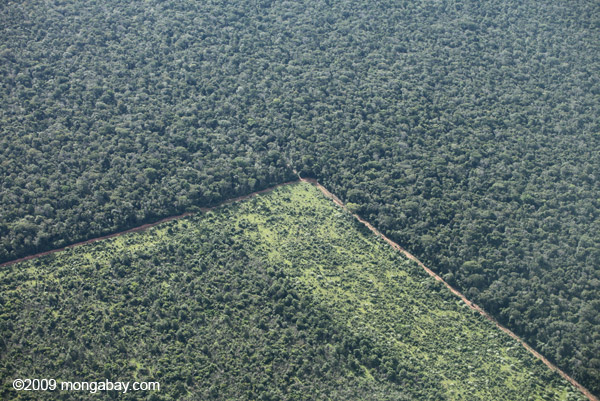
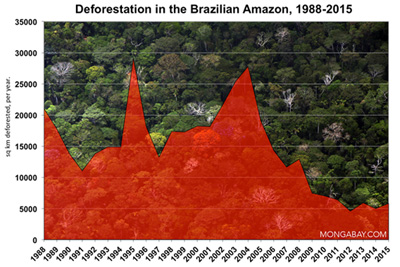
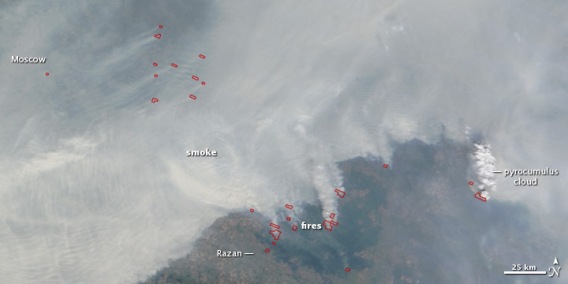
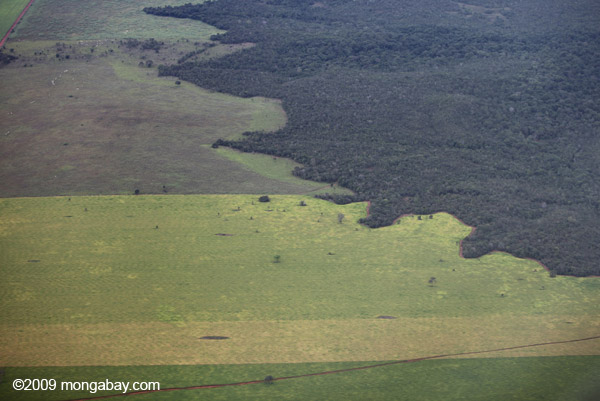

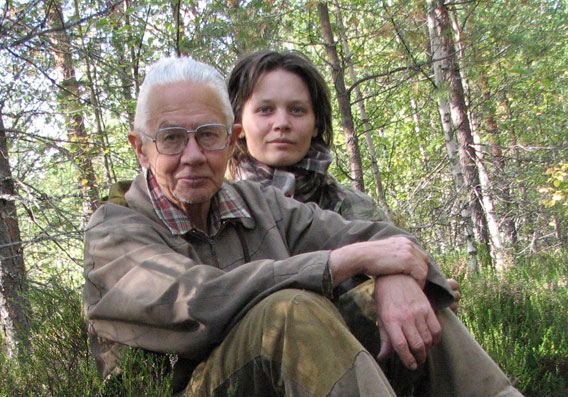
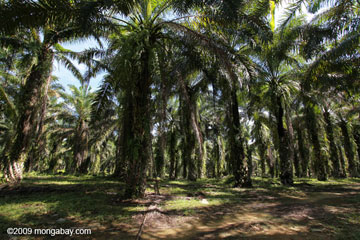
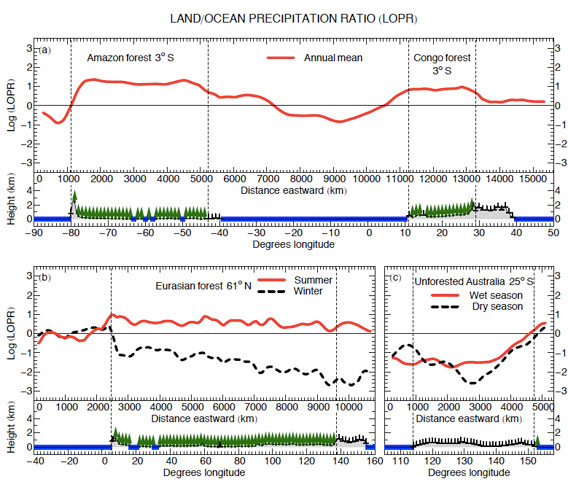

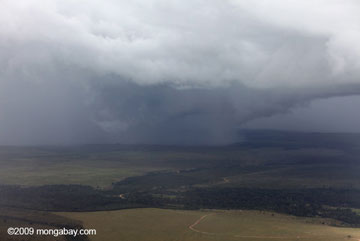

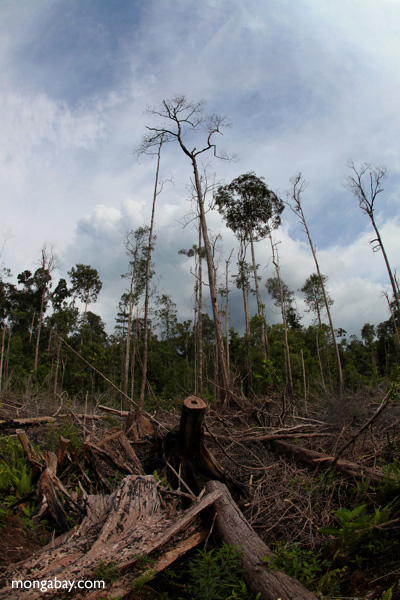

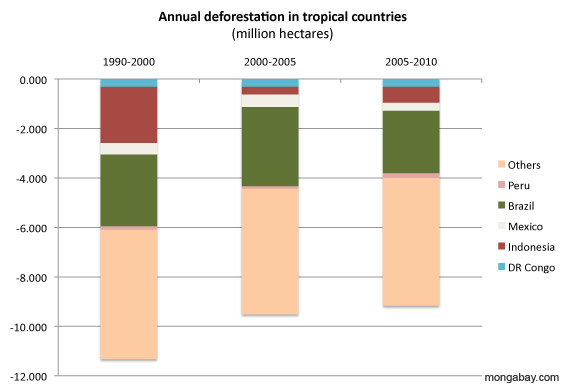
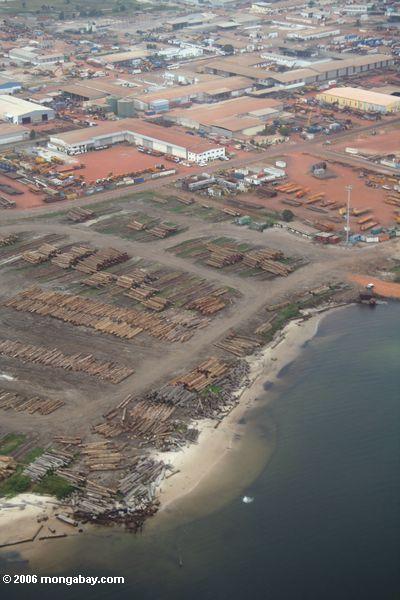
 (04/01/2009) Two Russian scientists, Victor Gorshkov and Anastassia Makarieva of the St. Petersburg Nuclear Physics, have published a revolutionary theory that turns modern meteorology on its head, positing that forests—and their capacity for condensation—are actually the main driver of winds rather than temperature. While this model has widespread implications for numerous sciences, none of them are larger than the importance of conserving forests, which are shown to be crucial to 'pumping' precipitation from one place to another. The theory explains, among other mysteries, why deforestation around coastal regions tends to lead to drying in the interior.
(04/01/2009) Two Russian scientists, Victor Gorshkov and Anastassia Makarieva of the St. Petersburg Nuclear Physics, have published a revolutionary theory that turns modern meteorology on its head, positing that forests—and their capacity for condensation—are actually the main driver of winds rather than temperature. While this model has widespread implications for numerous sciences, none of them are larger than the importance of conserving forests, which are shown to be crucial to 'pumping' precipitation from one place to another. The theory explains, among other mysteries, why deforestation around coastal regions tends to lead to drying in the interior.  (12/19/2011) Brazil, which last week moved to reform its Forest Code, may find lessons in Russia's revision of its forest law in 2007, say a pair of Russian scientists. The Brazilian Senate last week passed a bill that would relax some of forest provisions imposed on landowners. Environmentalists blasted the move, arguing that the new Forest Code — provided it is not vetoed by Brazilian President Dilma Rousseff next year — could undermine the country's progress in reducing deforestation.
(12/19/2011) Brazil, which last week moved to reform its Forest Code, may find lessons in Russia's revision of its forest law in 2007, say a pair of Russian scientists. The Brazilian Senate last week passed a bill that would relax some of forest provisions imposed on landowners. Environmentalists blasted the move, arguing that the new Forest Code — provided it is not vetoed by Brazilian President Dilma Rousseff next year — could undermine the country's progress in reducing deforestation.  (12/08/2011) Researchers have garnered further evidence for a smoking gun behind the fall of the great Maya civilization: deforestation. At the American Geophysical Union (AGU) conference, climatologist Ben Cook presented recent research showing how the destruction of rainforests by the Mayan ultimately led to declines in precipitation and possibly civilization-rocking droughts. While the idea that the Maya may have committed ecological-suicide through deforestation has been widely discussed, including in Jared Diamond's popular book Collapse, Cook's findings add greater weight to the theory.
(12/08/2011) Researchers have garnered further evidence for a smoking gun behind the fall of the great Maya civilization: deforestation. At the American Geophysical Union (AGU) conference, climatologist Ben Cook presented recent research showing how the destruction of rainforests by the Mayan ultimately led to declines in precipitation and possibly civilization-rocking droughts. While the idea that the Maya may have committed ecological-suicide through deforestation has been widely discussed, including in Jared Diamond's popular book Collapse, Cook's findings add greater weight to the theory.  (04/22/2010) The biodiversity crisis, the climate crisis, the deforestation crisis: we are living in an age when environmental issues have moved from regional problems to global ones. A generation or two before ours and one might speak of saving the beauty of Northern California; conserving a single species—say the white rhino—from extinction; or preserving an ecological region like the Amazon. That was a different age. Today we speak of preserving world biodiversity, of saving the 'lungs of the planet', of mitigating global climate change. No longer are humans over-reaching in just one region, but we are overreaching the whole planet, stretching ecological systems to a breaking point. While we are aware of the issues that threaten the well-being of life on this planet, including our own, how are we progressing on solutions?
(04/22/2010) The biodiversity crisis, the climate crisis, the deforestation crisis: we are living in an age when environmental issues have moved from regional problems to global ones. A generation or two before ours and one might speak of saving the beauty of Northern California; conserving a single species—say the white rhino—from extinction; or preserving an ecological region like the Amazon. That was a different age. Today we speak of preserving world biodiversity, of saving the 'lungs of the planet', of mitigating global climate change. No longer are humans over-reaching in just one region, but we are overreaching the whole planet, stretching ecological systems to a breaking point. While we are aware of the issues that threaten the well-being of life on this planet, including our own, how are we progressing on solutions?  (03/03/2010) Twenty years of research has led Dr. Graham Jones of Australia's Southern Cross University to discover a startling connection between coral reefs and coastal precipitation. According to Jones, a substance produced by thriving coral reefs seed clouds leading to precipitation in a long-standing natural process that is coming under threat due to climate change.
(03/03/2010) Twenty years of research has led Dr. Graham Jones of Australia's Southern Cross University to discover a startling connection between coral reefs and coastal precipitation. According to Jones, a substance produced by thriving coral reefs seed clouds leading to precipitation in a long-standing natural process that is coming under threat due to climate change.  (06/25/2009) Between 1700 and 1850 forest cover in India and China plummeted, falling from 40-50 percent of land area to 5-10 percent. Forests were cut for agricultural use across Southeast Asia to feed a growing population, but the changes from forests to crops had unforeseen consequences. A new study published in the Proceedings of the National Academy of Sciences links this deforestation across Southeast Asia with changes in the Asian Monsoon, including significantly decreased rainfall.
(06/25/2009) Between 1700 and 1850 forest cover in India and China plummeted, falling from 40-50 percent of land area to 5-10 percent. Forests were cut for agricultural use across Southeast Asia to feed a growing population, but the changes from forests to crops had unforeseen consequences. A new study published in the Proceedings of the National Academy of Sciences links this deforestation across Southeast Asia with changes in the Asian Monsoon, including significantly decreased rainfall.